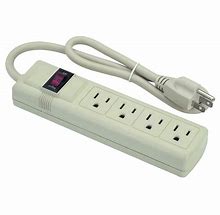They may always provide power, over time they will no longer prevent surges.
With crazy weather like we’ve been experiencing, soaked grounds and flooding, power outages, downed trees, landslides, and unpredictable storms can be a challenge for businesses and residences alike. Last month we shared a story of a business that because of a power outage experienced some long lasting effects.
Let’s talk about a few things that could provide a positive protection! How is power fed to computers and other electronic devices? These days it is rare to see a computer plugged directly into a wall socket, isn’t it? Maybe not a workstation but we often see laptops, iPads, or phones connected directly into the wall for recharging. That may not be a wise decision. If you have business servers, network gear, or specialty equipment in your office protecting them is critically important, don’t plug them directly into the wall!
The options for protection are based on a few simple decisions you can make:
- How often do your lights flicker in your home or office but you don’t lose power?
- Would the loss of the equipment due to a power surge be problematic for you if you were down for a few days?
- Do you want surge protection or require battery backup?
- How long have you had your current surge protector/suppression power strip?
 Surge protection or surge suppression are often used interchangeably. Starting with surge protection, those are usually the multi-outlet devices that have a power switch. Their basic function is to prevent those unstable power spikes from reaching your equipment. It is good to use these even for portable device charging and you can purchase on that has USB ports for portable devices. A note of caution, while they may always provide power, over time they will no longer prevent surges. These devices have a shelf life that depends on the reliability and issues with power. You will very often not know when they stop providing protection, as power is still provided to your devices. Some units may have an indicator light but many do not. When purchasing these protection devices, look for the joule rating. The higher the number the longer they may last. For example, a model with a 1080 joule rating would support 5 different 200 joule episodes. The challenge is you won’t know how to gauge each episode and you may not even be there when it happens. Your best bet is to invest in a device with an indicator light. The light will be a clear signal that replacement is needed. Without an indicator light replace the unit often, just like the batteries in your smoke detector. Remember that if you lose power completely your equipment most likely will shut down immediately.
Surge protection or surge suppression are often used interchangeably. Starting with surge protection, those are usually the multi-outlet devices that have a power switch. Their basic function is to prevent those unstable power spikes from reaching your equipment. It is good to use these even for portable device charging and you can purchase on that has USB ports for portable devices. A note of caution, while they may always provide power, over time they will no longer prevent surges. These devices have a shelf life that depends on the reliability and issues with power. You will very often not know when they stop providing protection, as power is still provided to your devices. Some units may have an indicator light but many do not. When purchasing these protection devices, look for the joule rating. The higher the number the longer they may last. For example, a model with a 1080 joule rating would support 5 different 200 joule episodes. The challenge is you won’t know how to gauge each episode and you may not even be there when it happens. Your best bet is to invest in a device with an indicator light. The light will be a clear signal that replacement is needed. Without an indicator light replace the unit often, just like the batteries in your smoke detector. Remember that if you lose power completely your equipment most likely will shut down immediately.
Universal power supply and battery backup units, commonly referred to as UPS will often provide both surge protection and provide a battery source that will keep devices running when the power goes out. The battery life you purchase will determine how much time you have. Some devices on the market have a display of how much time is left, this is a useful feature. Note that not all the outlets may have surge protection so you may need to be selective on what you plug in to which outlet. Just like a surge protector, these devices don’t last forever, the batteries will deplete over time. Invest in one that will alert you when the  batteries are depleted. Don’t find out the hard way that they are gone. There are many on the market to choose from starting at just over $100. The very best and most useful feature of a UPS it that it will try to shut down your equipment gently, to prevent a hardware crash that you may or may not recover from.
batteries are depleted. Don’t find out the hard way that they are gone. There are many on the market to choose from starting at just over $100. The very best and most useful feature of a UPS it that it will try to shut down your equipment gently, to prevent a hardware crash that you may or may not recover from.
We often take our electrical power for granted, but when it comes to sensitive electronics even small fluctuations can be a problem. Whether you are protecting your home or your office, if you need assistance, call us!




